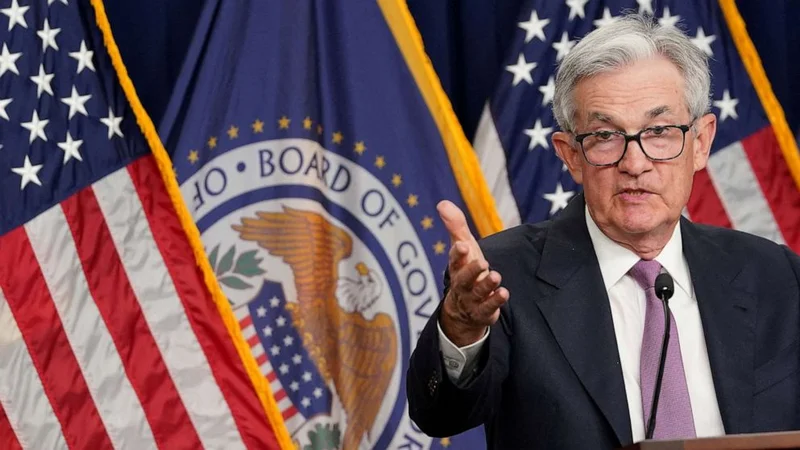For years, it has felt like we’ve been holding our breath. In the labs, in the garages, in the pitch meetings—the world of innovation has been running on fumes. Brilliant ideas have been shelved, ambitious projects deemed "too risky," and the relentless pace of progress we'd grown accustomed to felt like it was grinding to a halt, all under the immense pressure of tight money. But this week, something shifted. A quiet signal from the most unlikely of places—a speech by Federal Reserve Chair Jerome Powell—might just be the sound of the ice cracking.
When I read Powell’s comments, I didn't just see a headline about the economy. I felt a palpable sense of relief, a loosening of a valve that has been restricting the flow of pure, unadulterated ambition in the tech world for years. He spoke of "tension" between inflation and labor, of data challenges from a government shutdown, but between the lines of that carefully crafted Fedspeak was a message I believe is aimed directly at the future. The takeaway was clear: Fed’s Powell suggests tightening program could end soon, opens door to rate cuts. For those of us obsessed with building tomorrow, that’s not just a tweak to monetary policy; it’s a seismic event.
This is the kind of breakthrough that reminds me why I got into this field in the first place. It’s easy to get lost in the numbers, but what we're really talking about is the cost of a dream. Powell is signaling a potential change to the federal funds rate—in simpler terms, it's the foundational cost of money for the entire economy. When that cost is high, capital gets timid. It flows to safe, predictable bets. But when that cost goes down? Capital gets brave. It starts searching for the exponential returns that only come from true, world-changing innovation.
What happens when the smartest minds are no longer constrained by the cost of capital? What breakthroughs have been sitting on whiteboards, just waiting for a signal like this one?
To understand the magnitude of this moment, you have to stop thinking like an economist and start thinking like an engineer. Imagine the entire ecosystem of innovation—from startups to massive R&D labs—as a high-performance engine. For the past few years, the Federal Reserve, in its necessary fight against inflation, has been restricting the fuel line to that engine. The engine didn't break, but it was sputtering, running lean, and incapable of reaching its full potential.
Powell’s suggestion that the tightening might end, that cuts could be on the horizon, is like a hand reaching down to slowly open that fuel line back up. This isn't just about stock portfolios or mortgage rates, this is about the green light for that brilliant team in a garage working on quantum computing, it's about the funding for the AI that could personalize medicine, it's about the capital to build the sustainable energy grids we've all been dreaming of but were told were too expensive to try.

This is the modern equivalent of the patronage that fueled the Renaissance. The bankers and merchants of Florence didn't just fund paintings; they funded a paradigm shift in human consciousness by giving geniuses the resources to create without constraint. We are on the cusp of a similar moment. While some critics, as Powell himself noted, are busy looking in the rearview mirror, debating the asset purchases of 2021, they're missing the bigger picture. Hindsight is easy, but foresight is what builds tomorrow. Powell's signal isn't about correcting the past; it's about enabling a radically different future.
Of course, with this new flood of potential comes profound responsibility. We can’t just fund another dozen food-delivery apps. This moment calls for vision. It demands that we direct this new energy toward solving the grand challenges—climate, disease, resource scarcity. The question for us, for every investor, founder, and engineer, is no longer just "Can we build it?" but "What should we build?"
You can already feel the shift in the air, a change in the digital ether. The usual cynicism on forums like Reddit is being pierced by a cautious but electric buzz. Threads are popping up where people are asking, "Is this it? Is the innovation winter finally thawing?" This isn't just wishful thinking; it's the collective sensing of a changing environment, like animals emerging after a long winter.
Powell admitted that with the "clarity of hindsight," the Fed's past actions could have been different. That humility is welcome, but what’s more important is the implicit forward-looking statement: they have learned. They see the "softer labor market" and the "downside risks" not just as economic data points, but, I believe, as a human cost. They understand that a stalled economy is a stalled society.
This isn't a guarantee. The FOMC still has to vote. The data, as Powell noted, is still murky because of political squabbles. But the direction of the current has changed. The signal has been sent. For anyone who has felt like they've been pushing a boulder uphill, this is the moment the incline starts to level out. This is the permission structure the entire tech world has been waiting for.
So, what do we do now? We prepare. We dust off those ambitious plans. We reconnect with our teams. We refine the pitches for the ideas that seemed too big, too bold, too expensive just a few months ago. The starting gun hasn't fired yet, but the runners are being called to the line. And the race to build the future is about to begin again, in earnest.